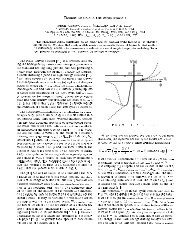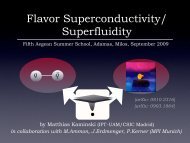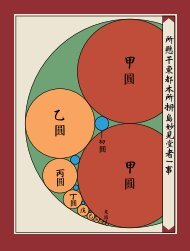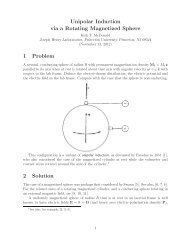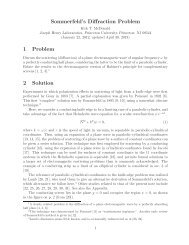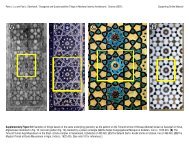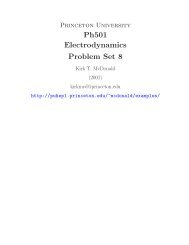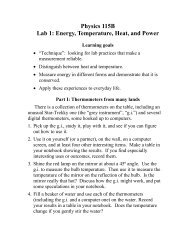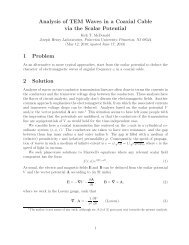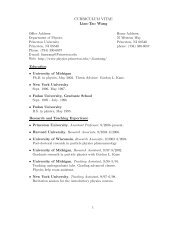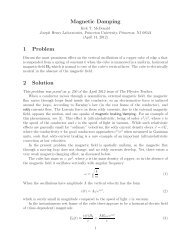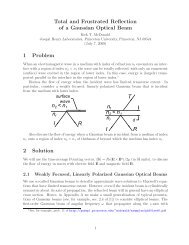Polarization Dependence of Emissivity - Physics Department ...
Polarization Dependence of Emissivity - Physics Department ...
Polarization Dependence of Emissivity - Physics Department ...
Create successful ePaper yourself
Turn your PDF publications into a flip-book with our unique Google optimized e-Paper software.
are different in general. Thus, the concepts <strong>of</strong> parallel and perpendicular polarization and<br />
<strong>of</strong> the angle <strong>of</strong> the radiation are not well defined after integrating over the entire volume.<br />
Thermodynamic equilibrium can exist only if a single spectral intensity function K(ν, T )<br />
holds independent <strong>of</strong> polarization and <strong>of</strong> angle.<br />
All that remains is to evaluate the reflection coefficients R ⊥ and R ‖ for the two polarizations<br />
at a vacuum-metal interface. These are well known [1, 2, 7], but we derive them for<br />
completeness.<br />
To use the Fresnel equations (3), we need expressions for sin θ t and cos θ t . The boundary<br />
condition that the phase <strong>of</strong> the wave be continuous across the vacuum-metal interface leads,<br />
as is well known, to the general form <strong>of</strong> Snell’s law:<br />
k i sin θ i = k t sin θ t , (4)<br />
where k = 2π/λ is the wave number. Then,<br />
cos θ t = √ 1 − k2 i<br />
sin 2 θ<br />
kt<br />
2 i . (5)<br />
To determine the relation between wave numbers k i and k t in vacuum and in the conductor,<br />
we consider a plane wave <strong>of</strong> angular frequency ω = 2πν and complex wave vector<br />
k,<br />
E = E 0 e i(k t·r−ωt) , (6)<br />
which propagates in a conducting medium with dielectric constant ɛ, permeability µ, and<br />
conductivity σ. The wave equation for the electric field in such a medium is (in Gaussian<br />
units)<br />
∇ 2 E − ɛµ ∂ 2 E<br />
c 2 ∂t = 4πµσ ∂E<br />
2 c 2 ∂t , (7)<br />
where c is the speed <strong>of</strong> light. We find the dispersion relation for the wave vector k t on<br />
inserting eq. (6) in eq. (7):<br />
kt 2 = ɛµ ω2<br />
c + i4πσµω . (8)<br />
2 c 2<br />
For a good conductor, the second term <strong>of</strong> eq. (8) is much larger than the first, so we write<br />
where<br />
k t ≈<br />
√ 2πσµω<br />
c<br />
d =<br />
(1 + i) = 1 + i<br />
d<br />
=<br />
2<br />
d(1 − i) , (9)<br />
c<br />
√ 2πσµω<br />
≪ λ (10)<br />
is the frequency-dependent skin depth. Of course, on setting ɛ = 1 = µ and σ = 0 we obtain<br />
expressions that hold in vacuum, where k i = ω/c.<br />
We see that for a good conductor |k t | ≫ k i , so according to eq. (5) we may take cos θ t ≈ 1<br />
to first order <strong>of</strong> accuracy in the small ratio d/λ. Then the first <strong>of</strong> the Fresnel equations<br />
becomes<br />
∣<br />
E 0r ∣∣∣⊥<br />
= cos θ i sin θ t / sin θ i − 1<br />
E 0i cos θ i sin θ t / sin θ i + 1 = (k i/k t ) cos θ i − 1<br />
(k i /k t ) cos θ i + 1 ≈ (πd/λ)(1 − i) cos θ i − 1<br />
(πd/λ)(1 − i) cos θ i + 1 , (11)<br />
2



